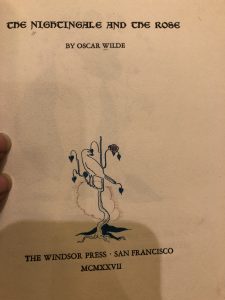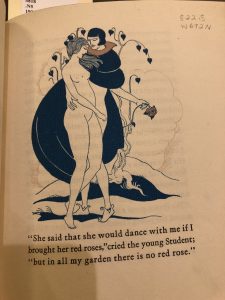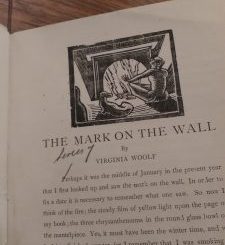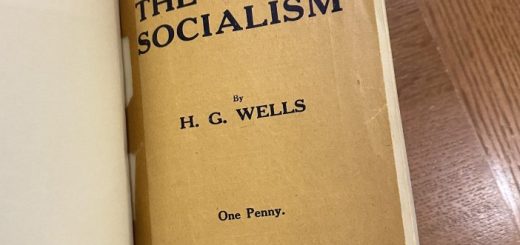“The Nightingale and the Rose” by Oscar Wilde
This hardcover version of “The Nightingale and the Rose” was published in 1927 by Windsor Press in San Francisco, and as the story was initially published in a collection in 1888, the reprint as its own, hardcover book suggests how popular and well-loved the tale is. Moreover, there were only four hundred copies printed, implying that the targeted audience was likely comprised of American fans of the story or of Wilde. The book is a bit smaller than the size of a typical book and is slim and portable with slightly yellow, frayed, sturdy pages. The copy is also worn, again pointing to its popularity and how it was read multiple times. As the story was published on its own versus published in a compilation like the original publication or the version we read in class, it gives the text individual attention and significance beyond being grouped or organized by being a short story of Oscar Wilde. I found it interesting how Wilde’s name is not on the cover of the book, further drawing attention to the story itself and not necessarily the author (although it may have been well known enough, especially by fans, that the author’s name was already known).
I also found the cover and use of images intriguing in regards to how it altered the way I read and understood the work. Oscar Wilde’s “The Nightingale and the Rose” follows the journey of a nightingale as she struggles to find a red rose for a student who wants to use it to ask the girl he likes to dance with him. The nightingale goes from tree to tree trying to find a red rose, and ends up sacrificing herself for the student, who is completely unaware of her efforts and attributes finding the rose to chance. However, he is ultimately rejected by the girl he likes, causing the student to throw away the rose and give up on love. The book is a moss green color, and the cover has the outline of a rose filled in with dark navy or black, with the title in white curving over the top of it. Despite the story resembling a fable or fairy tale, the colors are subdued with only the form of the rose being visible and dark, which to me felt like ominous foreshadowing and framed how I read the work. The rose takes up most of the space on the cover, emphasizing how the rose is a significant “character” or symbol in the work. The nightingale is also nowhere in sight, pointing to her sacrifice while highlighting the materialism of the student and how he disregards the nightingale, instead seeking a shallow token of a love he does not understand to woo the professor’s daughter. I found it really interesting how dark the rose and drooping leaf were, and the cover further emphasized for me the bleak aspect of the story in that, though the rose is filled with color by the emotional song of the nightingale, the nightingale’s love/life that colors the rose is unable to be seen or understood by the student. The dark outline or shadow of the rose also made me see the story as more poignant in that true love or genuine art may not exist in a society that tramples it for material wealth and book knowledge or that only has a superficial understanding of it.
The book is a moss green color, and the cover has the outline of a rose filled in with dark navy or black, with the title in white curving over the top of it. Despite the story resembling a fable or fairy tale, the colors are subdued with only the form of the rose being visible and dark, which to me felt like ominous foreshadowing and framed how I read the work. The rose takes up most of the space on the cover, emphasizing how the rose is a significant “character” or symbol in the work. The nightingale is also nowhere in sight, pointing to her sacrifice while highlighting the materialism of the student and how he disregards the nightingale, instead seeking a shallow token of a love he does not understand to woo the professor’s daughter. I found it really interesting how dark the rose and drooping leaf were, and the cover further emphasized for me the bleak aspect of the story in that, though the rose is filled with color by the emotional song of the nightingale, the nightingale’s love/life that colors the rose is unable to be seen or understood by the student. The dark outline or shadow of the rose also made me see the story as more poignant in that true love or genuine art may not exist in a society that tramples it for material wealth and book knowledge or that only has a superficial understanding of it.

The second image, on the title page, depicts the nightingale on the tree, presumably singing as the rose blooms. The leaves are shaped like hearts and the colors are limited to blue and red (for the rose and cloud in the background suggesting the onset of day). I feel that the illustration reflects and adds to to the fable/fairy tale-like nature of the work, with nature becoming more symbolic as the nightingale, with a true understanding of love, art, and emotion, is able to move those in nature who listen but not the closed off and pragmatic student who places book knowledge above life experience. I really like the inclusion of a small image on the title page, and I feel that the image made the story more tangible and imaginative to read.

The third illustration also reminded me of pictures in a fairy tale, and I was surprised at how it depicts the student and the girl that he likes together from the beginning (or maybe just a storybook couple), with two colors, a tree, and a rose that the student is holding. They seem to “cover” the nightingale from the previous image, blocking the tree and only taking the rose, which again illustrates the materialism of the student and his professor’s daughter as they see nature in terms of objects to take and ascribe monetary value to. Besides the cloak that the student is wearing, the two are also depicted as naked, which may point to a historical or mythical innocence associated with two people in love that no longer exists as people become less and less “simple” and seek wealth and status. I feel that the inclusion of a large image to begin the story altered the way I read it, making it seem more like a storybook with images and highlighting its fairy tale aspect (that is quickly undermined as the story goes on).
In terms of the formatting and layout, the pages are smaller and thus have less text on each page. The first line of the story is emphasized and is on the first page alone with the image, drawing attention to and setting up the need for a token or object for the student to realize the “ideal relationship” that he imagines in his head. While I continued to read the text in the version we read for class right after the first line without stopping, while I was reading the book version, I was able to think about it more and reflect on the jarring contrast between the image, which depicts the ideal relationship and the student with the rose, versus the present, in which the student has no roses in “his” garden to give her. I think that the text being spaced out more across the pages gives more room for reflection on the work, which I feel changed my experience in being able to better appreciate and trace the nightingale’s path as she seeks out the rose.
Overall, the presentation of the short story on its own in a book format with images emphasized certain aspects of the work for me when I read it, such as how the ideal “fairy tale” nature of the text is actually undermined as romanticized notions of love are destroyed by people’s preoccupation with money and material objects. The book also offers a later perspective on the story’s meaning three decades after the original was published. In particular, I thought that the use of the image to possibly represent the ideal relationship that the Nightingale sings of as she dies is effective in how it is only at the beginning of the story, setting up a deep contrast to think about as it remains a mere image or idea rather than something achievable by a society that values book knowledge over true emotion, sacrifice, and experience.









Thank you